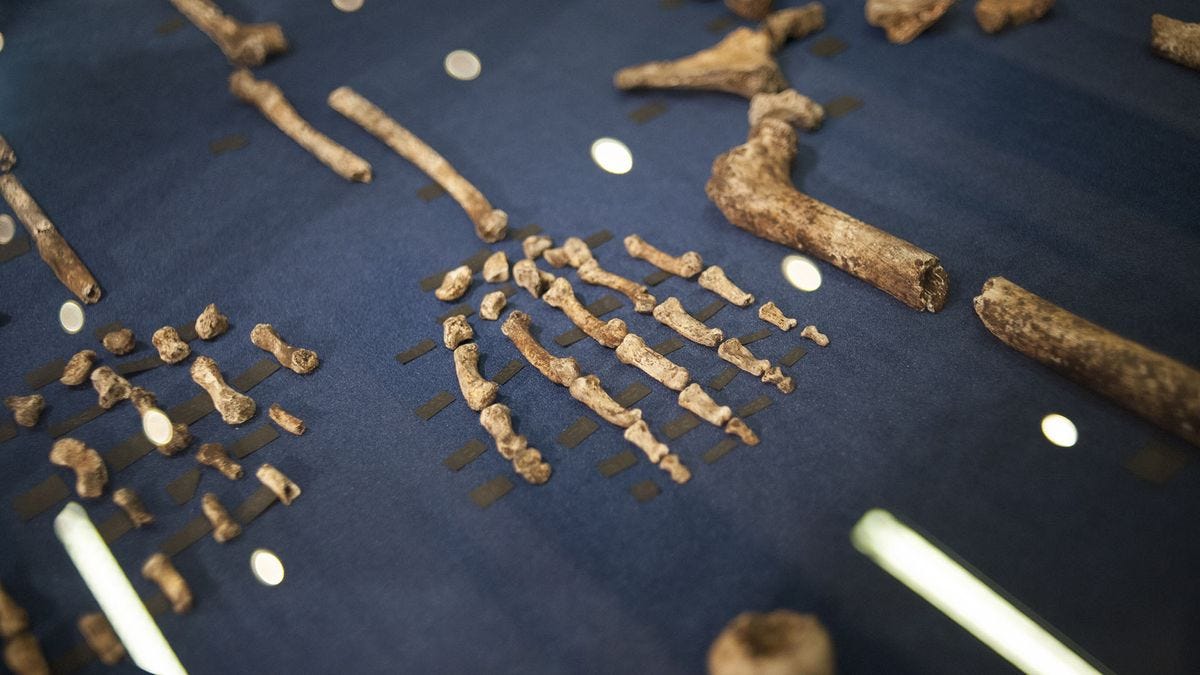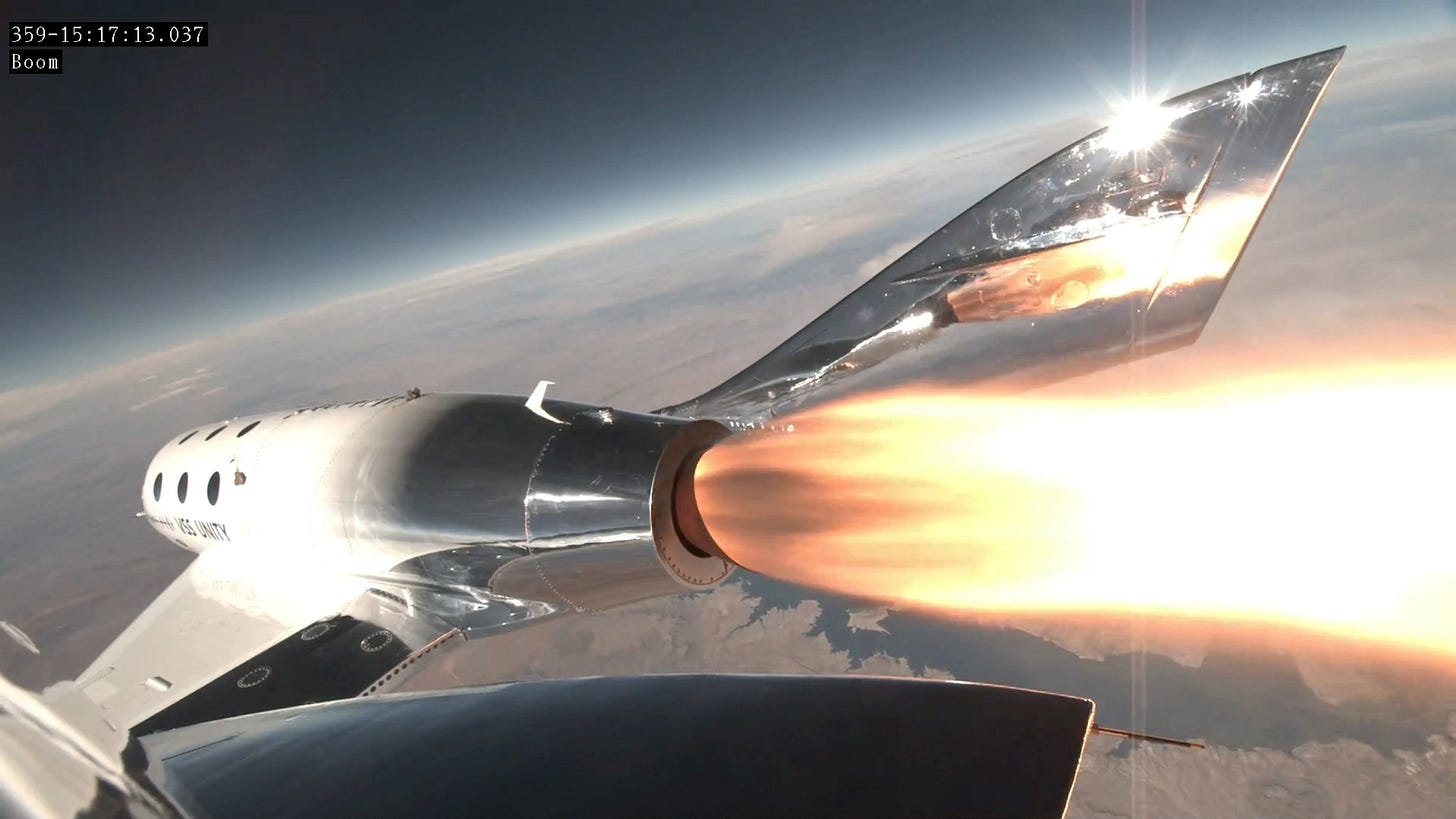It's AUSTRA-lopithecus not ASTRO-lopithecus, you weirdos
Ethical considerations of blasting our human ancestors' remains into space for no reason
In the latest installation of Why Would Anyone Do This, a September 8th Virgin Galactic spaceflight took two rare, nay, singular pieces of pre-human history for a low orbit ride alongside three billionaires, a flight instructor, and two pilots.
A shoulder bone from 2 million-year-old Australopithecus sediba and a thumb bone from 250,000-year-old Homo naledi were granted temporary leave from South Africa by the South African Heritage Resources Agency (SAHRA) to be carried to New Mexico where the launch took place. National Geographic paleoanthropologist Lee Berger filed for the export permit, while South African businessman Tim Nash carried the specimens on board the flight.
[Sidenote about Tim Nash: his father made a fortune in aviation, and Tim has spent millions over the last few decades buying up land in the so-called Cradle of Humankind in eastern South Africa. It was on his land where Lee Berger’s teams discovered A. sediba. Nash is working to turn this region into a private “paleotourism” hotspot.]
We could quickly go down the road of describing the colonial history of archaeology, anthropology, and similar disciplines, but I’d rather just show your these resources and encourage you to consider why the British Museum, for example, currently houses cultural artifacts belonging to Indigenous peoples, priceless objects for ethnic groups within former British colonies, and remains from ancient civilizations that have no relationship to Britain (not that it would be better that way).
To quote Sapiens.org, an anthropological publication out of the University of Chicago,
[Archaeology] helped create narratives about the inferiority of colonized groups based on their ancestors’ material culture. Many sacred objects and remains currently in museums were stolen from burial sites that were desecrated during the colonial period. These items and remains were often displayed in ways that were horribly inappropriate according to Indigenous traditions and ethics.
Give the stuff back!
From LiveScience’s take on the story:
Yonatan Sahle, an archaeologist at the University of Cape Town, says that sending African fossils to space reminds him of colonial and neocolonial research practices, in which white, mostly European and American researchers bent African institutions to their will. “As someone who is African and who is based in an African institution, this is basically a perpetuation of past, very ugly aspects of palaeoanthropological research.”
Knowing what we know, it’s no surprise that the response to this escapade has been to call it everything from “horrifying” to “callous and unethical” while decrying SAHRA for issuing the permit in the first place. Lee Berger applied for the permit by describing the purpose of the trip as “for a space flight for the promotion of science and discoveries in South Africa.”
The promotion of science and discoveries in South Africa? Dude, just buy some advertising space. Sponsor some school groups to come by. Invite some local experts in the field to work at the sites. It seems awfully short-sighted to decide the best way to promote ancient hominin paleoanthropology in South Africa is to risk the destruction of its discoveries altogether.
No kidding,
The shoulder bone is especially valuable because it was the first A. sediba fossil to be discovered and is the reference, or type specimen, that defines the species.
The University of the Witwatersrand’s defence of their decision to allow Berger to apply for the export permit centred on the claim that the remains had been “extensively studied” and documented prior to their release. But there are few casts of H. naledi available for study in general, and they are generally only accessible for researchers out of financially and materially rich countries. That is, not many African researchers can gain research access. The entitlement of Berger and Nash, and the naïveté of SAHRA are too glaring to ignore. No amount of risk mitigation in the pursuit of this space flight could account for the damage (to the specimens themselves, to the university’s reputation, to SAHRA, to the future of paleoanthropological research) if anything went wrong at any point.
My question is simple. Where is the need for promotion here? Scientific wonder is not contingent on the stunts of people who are so rich that they need to give Richard Branson millions of dollars for an hourlong sub-orbital flight. Reasonable, accessible sources of scientific wonder can be found on TikTok! On YouTube! At school! On the news! In books! In movies! In real life live streams from Mars! It’s really a matter of knowing where to look.
This event is somehow both the most boring thing a rich person can do and the most brain-meltingly cynical decision I’ve ever seen. In a world where wealth inequality and climate crises are front page news every day, this is the choice? Kick out a squillion kilograms of greenhouse gas emissions, throw away millions of dollars, endanger an irreplaceable artifact of human evolution, all for the publicity? I simply cannot believe it.
There’s an entire episode of The West Wing dedicated to this very question: how do we get people to care about science? About the future of our world? About the possibilities beyond the solar system? In the episode, the answer is “emotionally compelling rhetoric” but it’s also to fund education and research, from preschool to postdoctorate, and letting the scientists share their findings without political interference while letting the public take in scientific events without barriers.
The “good version” of the speech starts at 3:19 but the whole clip is worth watching if you have a second.
University College of London archaeologist Rachel King said it best:
"If I document one of South Africa’s World Heritage Sites, could we then bulldoze it and put up a shopping mall?"
A scan, a cast, a replica, a 3D rendering is not the same as the real thing. Yes, preserving the subjects of our scientific pursuits not only allows us to dig deeper into their physical condition, but it also maintains the connection to the past that we need to continue learning about humanity, starting from the very beginning.
Read the entire Scientific American article here (and if you’ve used up your free views this month, here’s a non-paywalled version).



